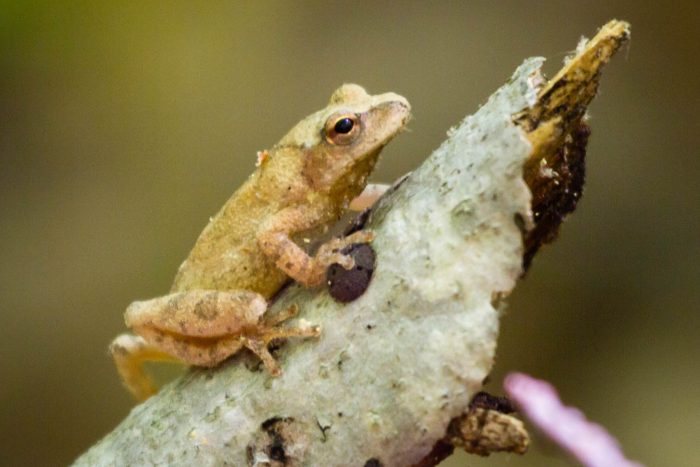Northern Spring Peeper
Pseudacris crucifer crucifer
The northern spring peeper is a tiny, brownish tree frog with a distinctive X-shaped cross on its back. It lives in marshy woods and near ponds and swamps throughout the Chesapeake Bay watershed. Its “peeping” call is one of the first signs of spring in the region.
This section shows one large critter image at a time. Use the thumbnails that follow to select a specific image to display here.

This gallery contains a grid of small thumbnails. Selecting a thumbnail will change the main image in the preceding section.
Appearance
The northern spring peeper varies in color from grayish brown to olive. They have a dark X-shaped cross on its back and a whitish belly. It has a dark bar between its eyes and dark bands on its legs. A vocal sac under its chin puffs out when making a call. Large, sticky toe pads on each of its webbed feet help in climbing trees and other plants.
Feeding
Spring peepers feed on small insects such as ants, beetles and flies, as well as spiders.
Predators
Preyed upon by many animals, including owls and other birds, snakes, salamanders and large spiders.
Voice
Males emit a high, piping whistle or “peep” once every second during breeding season. Calling may be louder on humid evenings or after a warm spring rain, when males congregate.
The northern spring peeper’s distinctive call is one of the first signs of spring in March. Males also make a lower-pitched trilling whistle when another male moves too close to its calling site.
Reproduction and life cycle
Spring peepers breed from March until June in freshwater ponds without fish. The male’s call is extremely important during breeding season. Females choose their mate based on the quality of the call. The faster and louder he sings, the more likely he is to find a mate.
Females lay hundreds of eggs in the water. The clumps of eggs attach to twigs and aquatic vegetation. Once breeding season is over, peepers move into woodlands and shrubby areas. Eggs hatch within 6 to 12 days, depending on temperature. Tadpoles are able to breathe with gills and swim using a tail.
The tail of a tadpole actually makes them larger than adult peepers. As they mature, tadpoles lose their tail and develop lungs for breathing. Within eight weeks, tadpoles are fully transformed into young frogs and leave the pond.
Peepers grow to their adult size by the end of the summer and reach maturity within one year.
Did you know?
- Peepers are the smallest and most well-known treefrog in the Chesapeake Bay region.
- They are among the first animals to call and breed in spring.
- Northern spring peepers are excellent climbers due to their large toe pads; however, they prefer to remain close to the ground.
- The X on the northern spring peeper’s back isn’t always perfectly formed, but it is present in some way. This identifying mark is where the peeper gets part of its scientific name: crucifer, from the word “crucifix.”
- The spring peeper’s vocal sac is almost the same size as its entire body
- Northern spring peepers produce glucose and “freeze” themselves to hibernate during winter. They return to normal when temperatures warm up again.
- These frogs are noctural.
Sources and additional information
- Chesapeake Bay: Nature of the Estuary, A Field Guide by Christopher P. White
- Northern Spring Peeper – Maryland Biodiversity Project
- Northern Spring Peeper – Virginia Department of Game and Inland Fisheries
- Animal Diversity Web: Pseudacris crucifer – University of Michigan Museum of Zoology
